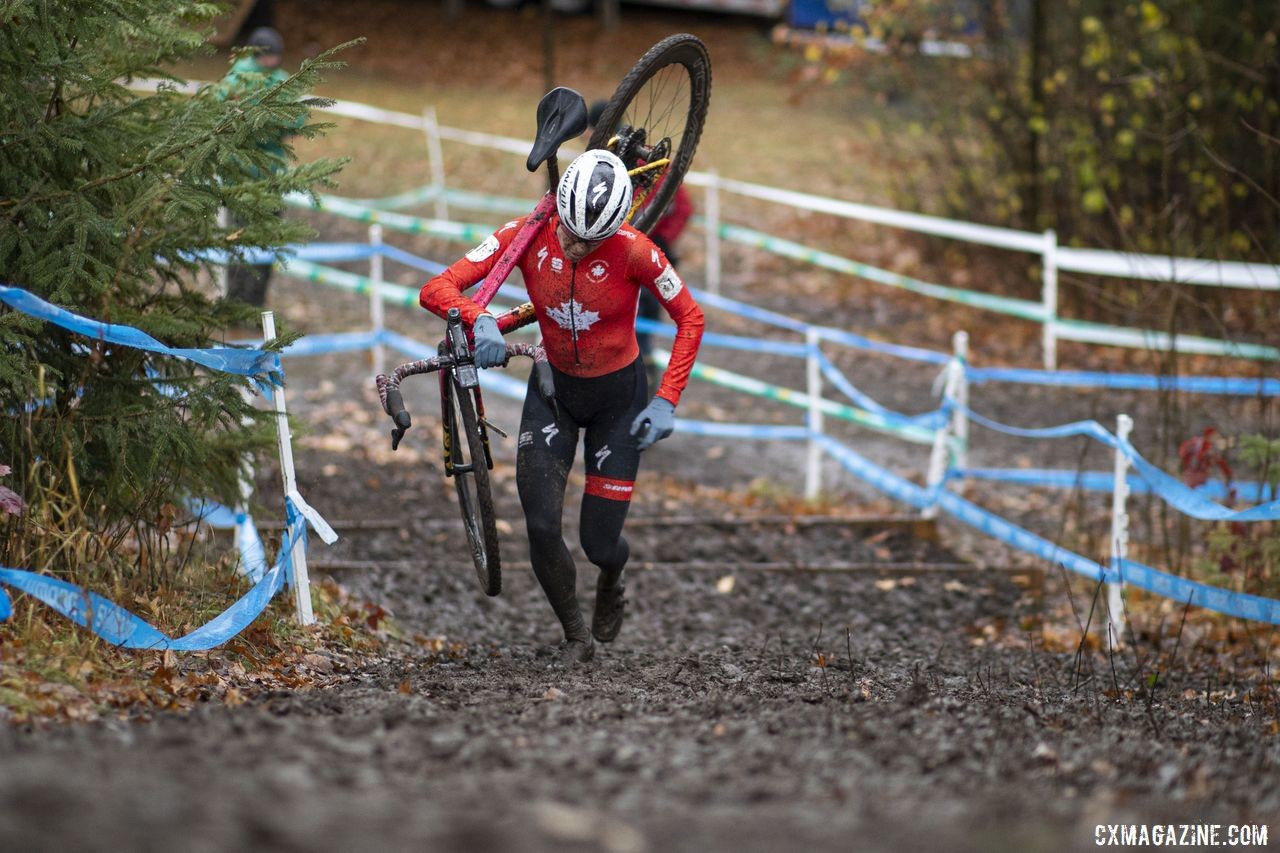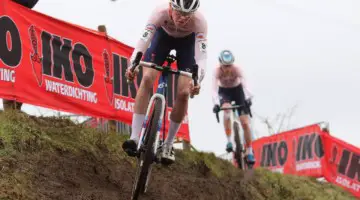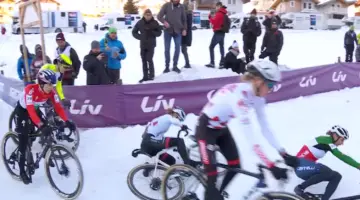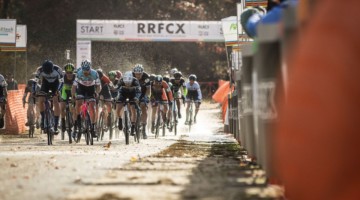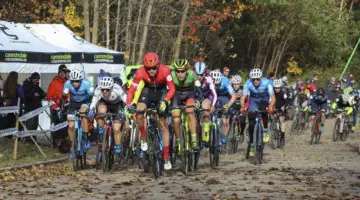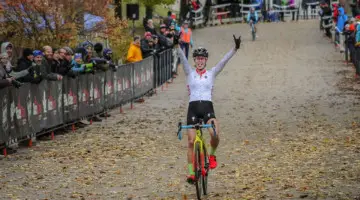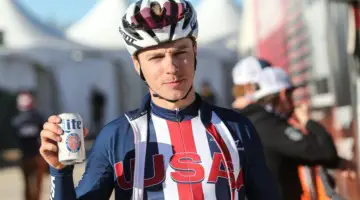Even before Sunday’s Pan-American Championships, Maghalie Rochette (Specialized x Feedback Sports) had a dream run through the 2019 domestic cyclocross calendar. She won her first career World Cup at Jingle Cross, won Canadian Nationals, won all 3 U.S. UCI C1s and won 9 total races.
Winning Sunday’s race and taking the Pan-Ams jersey for the second-straight year would no doubt be the perfect way to cap her two months of top-level racing.
However, if you wanted to point to one thing that gave Rochette some trouble this fall, it would be the mud. After winning the Jingle Cross World Cup, she finished fifth at World Cup Waterloo (still a great result!) and then had her toughest day of the season at FayetteCross Day 2.
Historically, Rochette has raced well in bad conditions, so the whole experience was a little confusing.
“Somehow I’ve had some bad races in the mud this year,” she said. “I guess it was mostly just one in Fayetteville; I had a hard time there. Then at the Trek World Cup, I’m happy about the result I had, but I felt like I didn’t really race super well. Those were both in the mud, and for a while, I was like, ‘Oh no, what’s happening? Why am I having such a hard time?'”
Being successful at cyclocross takes skill, preparation, concentration and training, but sometimes, it also takes a little luck. In Rochette’s case, that luck came in the form of rain and messy conditions on Day 1 of Kings CX in Cincinnati.
Rochette was not planning on racing that weekend, but when she heard the mud was coming to Kingswood, she made her plans to race the C1 and conquer the mud demons that had haunted her for that past month.
On a slick, messy, sloppy afternoon, Rochette won the race and got her mud groove back. When rains hit right before Canadian Nationals, she again rose to the occasion and raced confidently and smoothly to the win.
All of this is relevant to Pan-Ams because some mid-week snow and weekend rain make it slick and messy yet again. Thanks in large part to that day in Cincinnati, Rochette was ready for what Midland and mother nature had to offer.
She raced out to a fast start and did not look back en route to her second-straight Pan-Ams title. She now heads to Tabor this weekend and then eagerly awaits a training block before heading back to Europe for World Cup Namur in a little over a month.
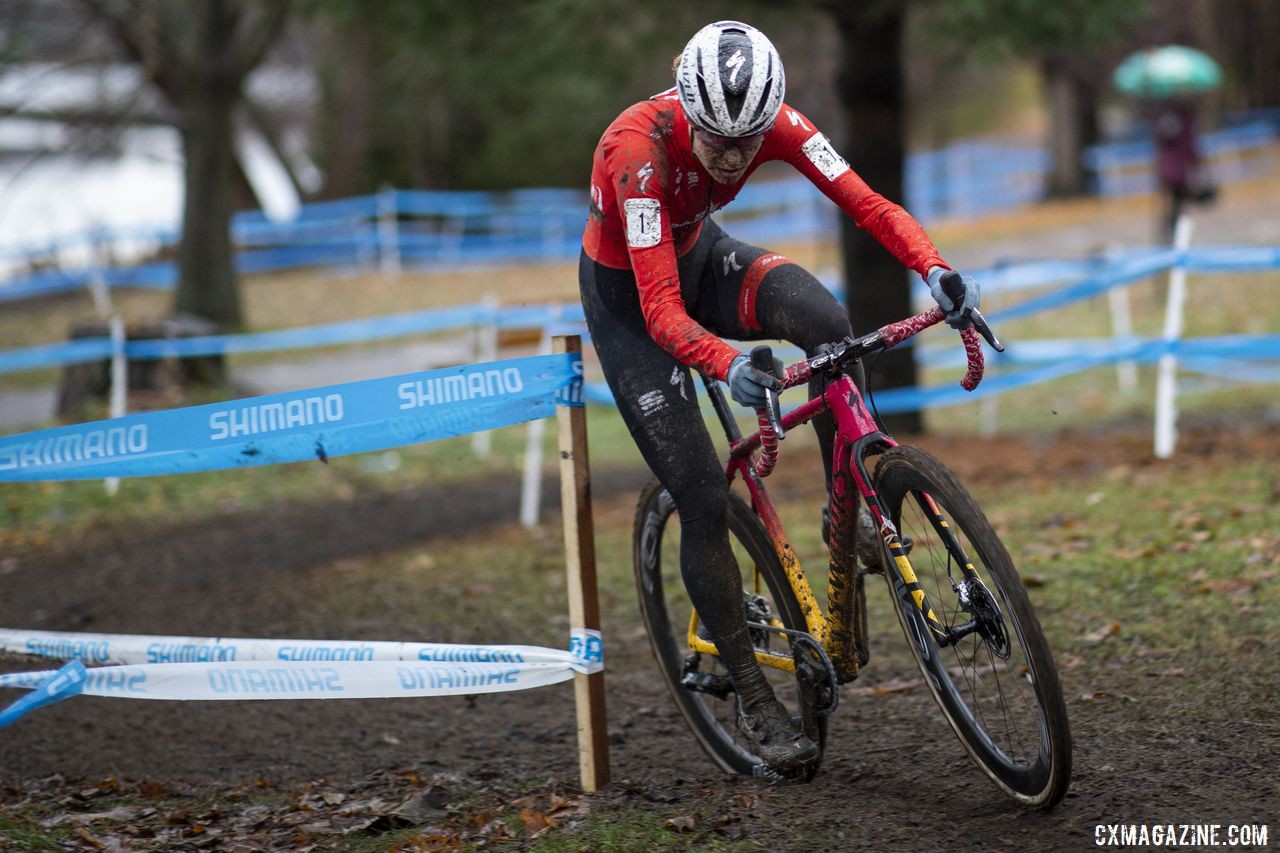
Maghalie Rochette mastered the mud at the 2019 Pan-American Cyclocross Championships. © Nick Iwanyshyn
I chatted with Rochette about her Pan-Ams win and her season thus far. You can read a transcript of our conversation below.
Interview: Maghalie Rochette, 2019 Pan-American Champion
Cyclocross Magazine: Pan-Ams two years in a row now. How does the second one feel compared to the first?
Maghalie Rochette: It’s not easy to defend the title. There was definitely a lot of stress going into the event, but still, it’s a championship race, so you know everyone wants to win and it’s a little different than a normal race. I was a little nervous, but it feels really good to defend it.
CXM: We kind of talked about it in the preview, but talking to Becca and Clara, they were like, “We’re kind of looking at what Maghalie is going to do.” Does that affect you hitting the start line knowing that?
MR: No, I don’t think it affects me. The way the other people think about me, I think about them the same way, if that makes sense. I kind of know how everyone races, and I know my strengths and weaknesses compared to them. It really goes both ways. I feel the same way about them that they feel about me.
For me, it doesn’t really change anything. I had a game plan going into the race, and really, all you can control is what you are doing, no matter how strong or how well the other people are riding. That’s really what I was focusing on, and that helps me feel more in control and more confident. That’s kind of how I felt.
CXM: I talked to Kerry Werner yesterday, and he and Curtis White decided to skip Saturday’s race. Why did you decide to race both days? And did you think at all about skipping Saturday’s race?
MR: I did not think about skipping it. I think it was kind of a good opener and a good way to get used to the course and get to know it at speed. So I wanted to do the race on Saturday. The previous weekend at Nationals, I raced Nationals on Saturday but then didn’t race on Sunday. I wanted to get home as quickly as possible.
I got home and kind of took it easy on Sunday, Monday and Tuesday, and then I did two workouts on Wednesday and Thursday and took it easy on Friday. I actually drove 7 hours to Midland on Friday and didn’t pre-ride the course. For me, Saturday was that. I wanted to pre-ride and use the race as a way to get ready for Pan-Ams.
CXM: One thing that was really memorable for me last year, Saturday’s result wasn’t the best but I remember you crushing it after an early mistake in that race before you went on to win on Sunday. How have you been continuing to mature and learn as a rider over the past year, minimizing those mistakes and being patient?
MR: Yeah, I have been working on that because I would say it’s not really my strength, especially when I am a little nervous and excited for a race. I tend to try a little too hard, and that’s when mistakes happen. I’ve been working on that, trying to stay calm. The way I talk about it with David [Gagnon], my partner, mechanic and coach, is to stay, “Calm, hard. Calm, hard.” Some sections I can go hard, and some sections I need to calm down. The goal of that is to get the most out of the race while minimizing mistakes.
I guess I’ve been working on that a lot, and that’s been something that has helped me have more consistent performances. I guess it took me a long time to realize that you rarely win a race by going 1 second faster on a corner, but you can lose it that way. Understanding that has been a big thing for me this year.
CXM: It seems like it’s a fine balance between pushing it through those features and not making mistakes.
MR: It is. You still want to go hard when you can pedal hard or run fast or something like that. Some corners and technical sections are worth going a little faster through them, but for others, if you’re not 100% sure you’re going to clear it, maybe it’s better to go a little slower and be sure you’re going to clear it and not lose any time.
It’s been hard to wrap my head around that and actually understand it, but once I started applying it and saw that it works, then I was like, “Okay, that’s true, it actually works.” I’m still working on it, but I think that’s been a big learning thing for me this year.
CXM: The conditions at Pan-Ams were pretty sloppy and definitely muddier than last year. It seemed like a bad day for panicking or getting a little overexcited. What was your approach to handling the conditions and dealing with the weather?
MR: Sometimes it can get a bit stressful when conditions change a lot. That’s another thing you have to be ready for in cyclocross. The conditions are always going to change, and you have to be adaptable and you have to be ready for whatever is thrown at you. In Midland, it was super slippery, kind of like Cincinnati on Day 1. Really slippy, not like deep mud.
Mistakes can happen really quickly in conditions like those, so again, it was really about not making mistakes and staying calm in the corners and the technical sections. That was part of my strategy; knowing the conditions were like that, I wanted to start fast and see if I could get away quickly because it’s easier to ride by yourself in those kinds of conditions. If you ride by yourself and you make a mistake, it’s only your fault, but if you’re riding in a group, you can sometimes make a mistake because of someone else.
You want to minimize your chances of making mistakes, so that was definitely a strategy this weekend.
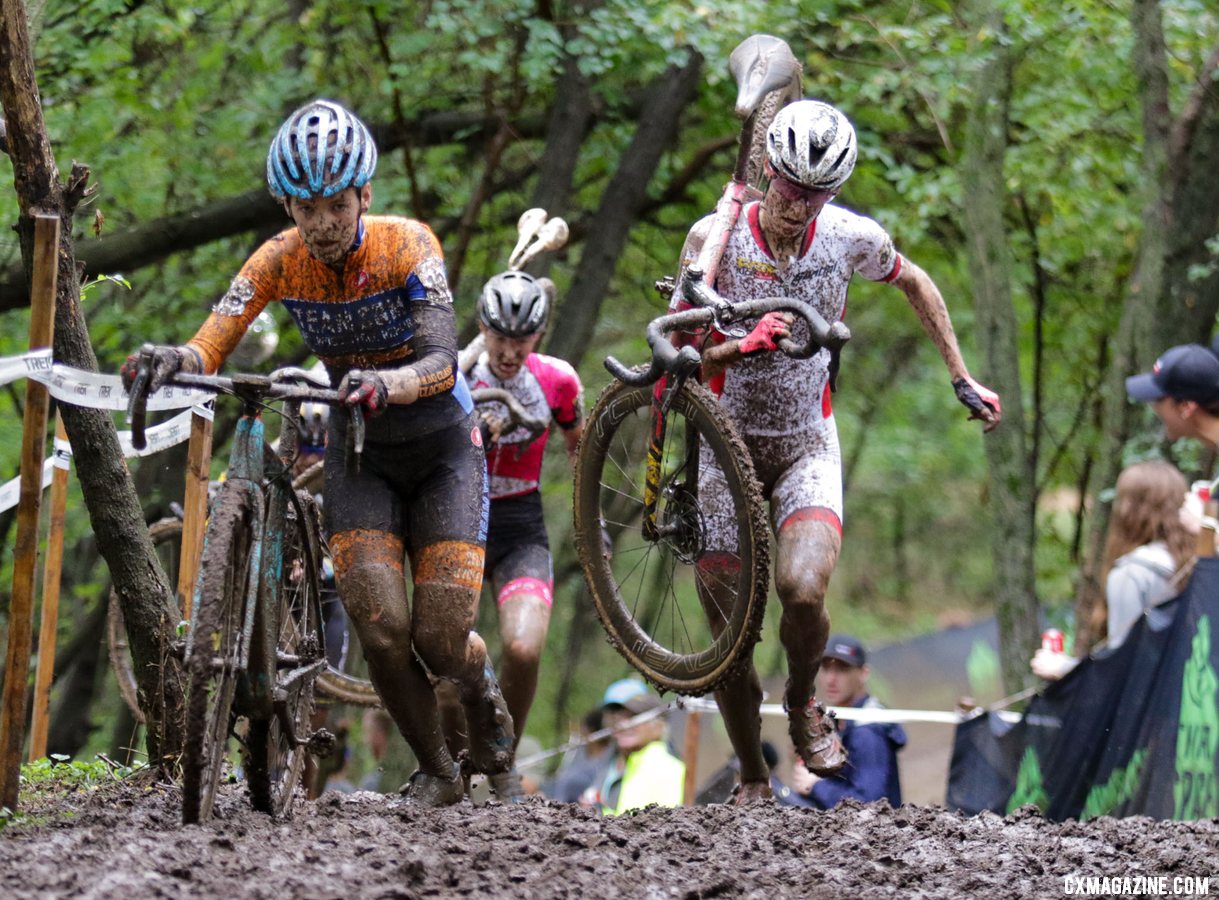
Maghalie Rochette has learned to be more patient in the mud. 2019 World Cup Waterloo, Elite Women. © D. Mable / Cyclocross Magazine
CXM: The last couple of races, you’ve shown yourself to be quite adept at racing in sloppy conditions at Canadian Nats and Cincy Day 1. What have the keys been for you in handling those slick conditions and keeping it upright while still racing fast?
MR: Somehow I’ve had some bad races in the mud this year. I guess it was mostly just one in Fayetteville; I had a hard time there. Then at the Trek World Cup, I’m happy about the result I had, but I felt like I didn’t really race super well. Those were both in the mud, and for a while, I was like, “Oh no, what’s happening? Why am I having such a hard time?”
I was not sure if I was going to go to Cincinnati, but when we saw they were expecting 40mm (1.5 inches) of rain, we decided to go there to practice riding in the mud. When we got there, we spent a lot of time out on the course when it was muddy.
David has a really interesting perspective and a much different way of seeing courses compared to how I ride. When we spent time on the course together, I got to get comfortable with riding in the mud again. I think that was a turning point for me, and I think I got my confidence back. In the past, I used to love the muddy conditions, so I am glad I had a few good races to kind of build my confidence back.
CXM: Admittedly, that’s been one of the storylines we’ve talked about on the Cyclocross Radio podcast, with Clara [Honsinger] getting the best of you in some of those mud races. Did you have motivation to prove to people that you could win in the mud?
MR: I wanted to prove it to myself. I knew in the past I have had good results in the mud, but I just had to prove it to myself this year. Who knows exactly what happened at those races. At Fayetteville, I think I just had a bad day, which happens to everyone. But also, I wasn’t very patient. Everything seemed slow for me. It was like tractor-pull kind of mud, so I kept changing lines and riding too much distance because it felt like each line wasn’t fast enough. I just wasn’t patient enough. Sometimes you just have to slug through the mud. Everyone was going slow, so you just need to accept that and try your hardest. That’s definitely one thing I learned there.
CXM: In Sunday’s race, it looks like you got an early lead. Where did you grab your lead early on?
MR: I wanted to start fast because, as I said, since the conditions were sloppy, it was easier to ride by yourself. I actually missed my pedal at the start, but I just kind of kept pedaling. Ellen [Noble] got a good start, so I went on her wheel to kind of save energy a little bit. I went around her just before we hit the mud in the first corner.
My plan was to go really hard the first lap, and I kind of slowly opened a little gap. When I saw I had a small gap of about 5 or 10 seconds, I decided to go even harder in the second lap to keep it growing. Then honestly, I kept pushing. I kind of kept it safe, but at the same time, I kept going hard. I wanted to give my best, and you never know when someone is going to get back to you or if you’re going to crash and get passed. I wanted to give my best performance for the whole race.
CXM: Was it equally as awesome as last year having the Canadian crowd?
MR: It was super awesome. The cool thing was there were a lot of kids out there, and they were super excited. It’s cool when you hear your name being cheered. I don’t know if there were as many people as last year, maybe because it was super cold and rainy, but it was still a good turnout, and it’s always fun to have Canadians cheering for me.
CXM: You’re still pretty young, but more and more people are looking up to you. What’s that experience been like for you, being a role model of sorts for young cyclists?
MR: Thank you, I appreciate that. It’s been cool. The way I see it is I’ve had a lot of great role models and people who have taken me under their wings and mentored me and showed me the ropes. So for me, it’s important to try and do the same thing with other people. For me, those relationships start as a friendship and someone kind of asking questions, and then if the relationship is good, you definitely want to help.
My vision and the way I see things is it’s cool to help people because I want everyone to grow together. If people who are younger than me come and challenge me, I’m so happy about that because it’s a way for me to get better and try to find ways to improve. As I said, I’ve been lucky to have good role models, so it’s important for me to try and do the same with younger people if I can.
CXM: The first time we talked a few years ago, you talked about mentoring and working with Ruby West. What was it like seeing her win the U23 race and bring home another championship for Canada?
MR: That was really cool! We haven’t been training together as much anymore, but we’re still good friends. I’ve seen her progress a lot throughout the years, so it’s been really fun to see how she has improved and gotten better every year. That’s super cool, and she’s a really nice person, so I was so happy to see her win.
It was great for Canada, in general. We’ve never really been a cyclocross nation, but it’s cool we got two of the titles this year. Not that it’s a race against the U.S., at all, but it was great to see cyclocross in Canada is growing and some of us are getting great results.
CXM: It’s totally cool to say you want to beat the Americans.
MR: I mean, I like the Americans. I guess I want to beat everyone, but at the same time, I still want to be friends with them. Story of my life, I guess.
CXM: This interview wouldn’t be complete without asking about the sweet skid you did at the finish line. How was the execution on that?
MR: You know, I’ve been working with Specialized for a little over a year now, and I really enjoy the relationship and the bike. Every race I have so much fun on this bike, so I just thought if I just do a skid, maybe I could show the side of the bike. We always see it from the front, but it’s actually a cool paint job, and I wanted to show it off, so I thought I’d do a skid. But I skidded a little too much, so in all of the pictures, you don’t really see anything. I kind of messed that up.
That was the goal though. I just wanted to do a little shoutout to them because they’ve been so awesome. I truly enjoy riding this bike, and I thought it would be cool to showcase the bike at the finish line.
Back to back! Maghalie Rochette keeps her Pan-Am Cyclocross title! Topped off with a sweet skid! @maghroch @SilverGooseCX #panamcx #silvergoosecx pic.twitter.com/Q4FAMg3ij4
— Canadian Cycling Mag (@CanadianCycling) November 10, 2019
CXM: I know you’ll have plenty more chances to skid at the finish line in Europe at the World Cups and other races. Just looking at this domestic season as a whole, how did it go? What are your thoughts about part one of your season?
MR: It’s been really really cool. I’m certain it’s been my best season so far. I think the best part for me is we really dedicated all our training and preparation to cyclocross, and so it was cool to see that it worked. Being fresher heading into the season and having more time to train helped me be more fit, and it worked out for me. That makes me really happy, and I think it’s cool because it validates the work David and I did. Now we can say, “Okay, here’s something to build on because it worked.” So next year, we can build on the approach by keeping the things that worked and maybe changing a few things here and there.
You can always improve, but honestly, I think we really gave our best at each race we showed up to, and that’s something I’m proud of. I’m really happy about the first part of the season, and I’m even more motivated to keep working for the next half of the season.
CXM: For the training, you mean it was all the e-biking, right?
MR: For sure. For sure. Totally what it was.
CXM: What do you think the keys for you are going to be during this next block of going back and forth to Europe?
MR: Number one is to stay healthy because there are going to be a few back-and-forth plane trips. Staying healthy is important because if I’m not healthy, I can’t train and race properly. Everyone is different on this, some people like to gain fitness by racing, but I really enjoy doing training blocks. Like being home in one place for a couple of weeks and training hard. Like really hard. Dedicating my life to training for a few weeks. That gives me a lot of confidence, and I feel good when I’m doing that.
This season, we planned a block of training in November. I’m getting ready to head to Tabor right now, and then we’re going to Tucson for a training block before Kerstperiode. I think that’s going to be a key moment for me that will help me stay fit through the end of the season. I feel like in the past, I’ve always kind of faded at the end of December and through January because if you just race, you’re not training much. At least for me.
Just before that training period, I’m actually taking a couple of days off. I’m going to take a little break and just kind of pause the season for a few days, and that will help me start training hard again. I guess health, rest and training will be the key factors for me to make the second half of the season successful.
CXM: Are you doing Koksijde?
MR: No, that’s the only World Cup I am skipping. Skipping it will allow me to take that little break I was talking about. I can take that little break and still have three weeks before Namur. Maybe I’ll regret not doing it. Right now I really want to do it, but that’s the plan we set out to do, so I am going to stick with that plan.
CXM: Well, it sounds like the plan you have made thus far is working, so why not stick with it.
MR: Yeah, for sure. And if it doesn’t work, I’ll make changes for next year. I think you have to try things, and that’s what we’re trying for this year.
CXM: Awesome. Thanks for your time, and congrats again on everything you have accomplished.
MR: Yeah, thank you. It’s been fun.













